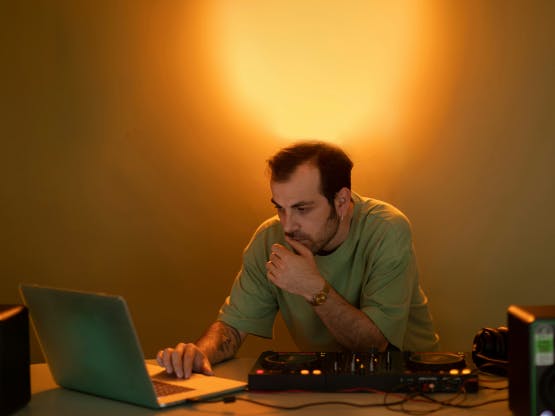Picture this. The lights dip, a deep‑filtered riser swells, and an other‑worldly voice whispers your tag – so fresh even Shazam throws up its hands. The kick detonates, phones fly up, and a thousand reels are born before the smoke clears. You didn’t book a vocalist. You didn’t bounce stems to a website. You stayed in‑session, let AI handle the night shift, and kept all the credit.
That one vignette captures the new producer’s paradox: listeners want human connection – but they expect post‑human sounds. Figuring out how those two instincts can coexist is what this article is about.
2025: The Year AI Becomes Your Back‑to‑Back Partner
AI vocals aren’t a futuristic party trick anymore; they’re a daily co‑writer in modern AI music production workflows. Over the last five years, producer adoption of AI plug‑ins has leapt from single digits to 25 % according to Music Connection’s 2024 survey. Meanwhile, club revenue sits above pre‑pandemic highs, and fans crave experiences that feel personal – the antidote to playlist sameness.
Yet one truth hasn’t changed since vinyl: crowds bond to the human behind the decks. Algorithms can pitch‑shift a syllable, but they can’t read a room or share the goose bumps of a perfectly timed re‑drop. The magic happens when AI handles the grunt work – pitch, formant, cloning – so you can stay in the moment, eyes up, and emotionally present.
So how do we turn silicon side‑kicks into real‑world dance‑floor moments? Stick around. In the next few scrolls we’ll zoom into the smallest ingredient – vocals that feel alive – then zoom back out to platform algorithms, year‑round release tactics, and the single AI plug‑in that stitches it all together. Follow through to the end and you’ll leave with a pocketful of tricks you can test at tonight’s sound‑check.
What Is an AI Vocal Plugin?
Think of an AI vocal plugin – sometimes called a voice changer plugin or simply voice ai – as a studio co‑pilot devoted entirely to vocals. It installs like any synth, but instead of spitting out MIDI‑controlled notes it processes recorded or imported vocals – reshaping timbre, pitch, and style in a single offline pass. Because it lives on a track inside the session – unlike web‑based vocal processors that require you to upload and download files – you can automate parameters, print takes, and mix it like native audio without ever leaving the DAW. Understanding how these plugins work will make the techniques in the next section click that much faster.
The Craft of Emotionally Charged Vocals
Great club records talk to people, not at them. Want to hear a proof‑of‑concept? Vocalist‑producer KARRA morphs a raw topline into a festival‑ready drop in this detailed demo – listen with headphones and notice how each micro‑timbre shift pulls you closer. Whether it’s MK’s chopped‑up “ah‑yeah” hooks or Honey Dijon’s preacher‑style call‑and‑response, the voice is the quickest shortcut to the spine. AI doesn’t replace that spark; it multiplies it.
From Call‑and‑Response to Storytelling
House and techno thrive on hypnotic repetition, but what elevates an earworm above wallpaper is the story inside the loop. Try stacking a clean vocal with a formant‑shifted clone panned wide. The slight timbre contrast hints at a dialogue, pulling audiences into a mini narrative without cluttering the mix.
Real‑world trick: Berlin‑based producer Marcus Sky tracks a single take, pitches a clone down seven semitones, and automates a slow‑motion panning sweep across his break sections. “People think it’s two singers trading lines,” he laughs, “but it’s just me and a plug‑in.”
Texture Is the New Loudness War
Listeners now scroll through more music in a day than crate‑diggers heard in a month. Grain, air, and micro‑timing imperfections stand out more than raw LUFS. Using AI‑driven formant control, you can age a vocal ten years, inject robotic grit, or smooth sibilants until they feel like velvet – all within one performance.
Layering Without Mud
Stacking identical doubles can choke side‑chains and blur house grooves. Instead, clone a line an octave down with a breathy formant tweak, LPF it at 250 Hz, then compress it in multiband mode. The spectral separation widens the mix while the kick still punches.
That vocal foundation sets the stage; now let’s weave it into workflows you can try tonight.
Workflow Playbook: From Studio Idea to Club Moment
1. Signature Drop in One Scene
Record a dry tag, drop your AI vocal tool on the channel, and automate a formant dive across eight bars. Print the take, slice the tail into sixteenths, and trigger them via drum rack for rhythmic chops that sound sampled, but are unmistakably you.
Creator inspo: Chicago duo Neon Steps layer a whispered female clone over a pitched‑down male tag, then side‑chain the render to a white‑noise riser for an “inhale” effect audiences mimic on the dance floor.
2. Live Mash‑up Key‑Lock
Drag an acapella into Ableton’s Session View, warp it in Complex Pro, and insert your AI plug‑in after Warp. Snap the Target Pitch to your instrumental’s root; timbre stays intact even when you drop a diva down to G minor. Instant bootleg without chipmunk artifacts.
Watch vocalist‑producer KARRA use the same technique in this Karra Music demo – proof that one vocal can spawn a festival‑ready banger before your latte cools. – proof that one vocal can spawn a festival‑ready banger before your latte cools.
3. Build‑Up Morphing
Automate the plug‑in’s wet/dry blend. Start 100 % clean during the verse, glide to 70 % robotic resonance for the snare roll, then snap back to dry on the downbeat. The contrast sells the impact without another riser sample.
4. Loop‑Maker Harmonies
Beatmakers living on 8‑bar loops can clone a single phrase into parallel fifths and thirds. Bounce each harmony, pan them 20 L/20 R, and filter‑sweep opposite directions. The call‑and‑response effect keeps ears engaged through long streaming sessions.
5. Hybrid DJ‑Set FX
If your mixer has USB send‑return, route your mic through a laptop running the AI plug‑in. Map a rotary to the Style knob: clean in the breakdown, gender‑flipped shout‑outs at the drop. It’s theatre audiences Instagram on the spot – and it works even in a back‑to‑back when you only have seconds to prep.
Feeling the momentum? Good, because none of it matters if nobody hears the track. Let’s talk platform algorithms.
Algorithmic Awareness: From Feed to Floor
The Five‑Second Filter
Spotify’s skip rate spikes after five seconds. Opening with a textured vocal hook – pitched‑down breath, hyper‑real whisper, or reversed reverb tail – can halve skips. AI lets you audition ten flavours of the same line until one sticks.
Loop‑Ready Structures
TikTok and Reels favour loops that restart cleanly. Write a 15‑second vocal‑lead loop that resolves on beat 1 and flip the timbre on the second repeat (formant +2 cents, slight distortion). Viewers feel progression without the algorithm flagging a “new” track.
Crest Factor & Loudness Normalisation
Platforms quietly prefer dynamic waveforms over brick‑walled masters. De‑essing and spectral smoothing via AI let you master hotter without shaving transient headroom. Result: louder‑feeling tracks that stream‑normalisation algorithms still boost.
That’s the data side. How do you stretch those insights across twelve months, not just festival season?
Staying Ahead All Year
Why it matters: Festival slots may crown reputations, but the 40 weeks between New Year’s fireworks and ADE are where catalog, community, and income grow. Consistency turns a breakout moment into a career.
Winter: Train custom vocal models, build drop‑pack assets, and soft‑launch ideas on Discord communities.
Spring: Tease edits on socials – short‑form clips that test vocal hooks against algorithm metrics.
Summer: Road‑test in clubs and festivals; tweak arrangements based on crowd response.
Fall: Release polished singles when playlist curators refresh catalogs. Rinse, repeat.
Small cycles, quick feedback, continuous iteration – that’s how producers like VXTR (lo‑fi/hip‑hop) release 30 singles a year while gigging three nights a week.
One Last Tool for the Toolkit
All the examples above were built with SoundID VoiceAI – a DAW‑native AI vocal plugin and voice changer plugin from Sonarworks that works entirely offline inside your DAW. Unlike web‑based services such as Kits.ai or Lalal.ai, everything is processed on your machine, so unreleased stems never leave your drive.
Grab the free trial, flip a vocal tonight, and watch the crowd reaction.




